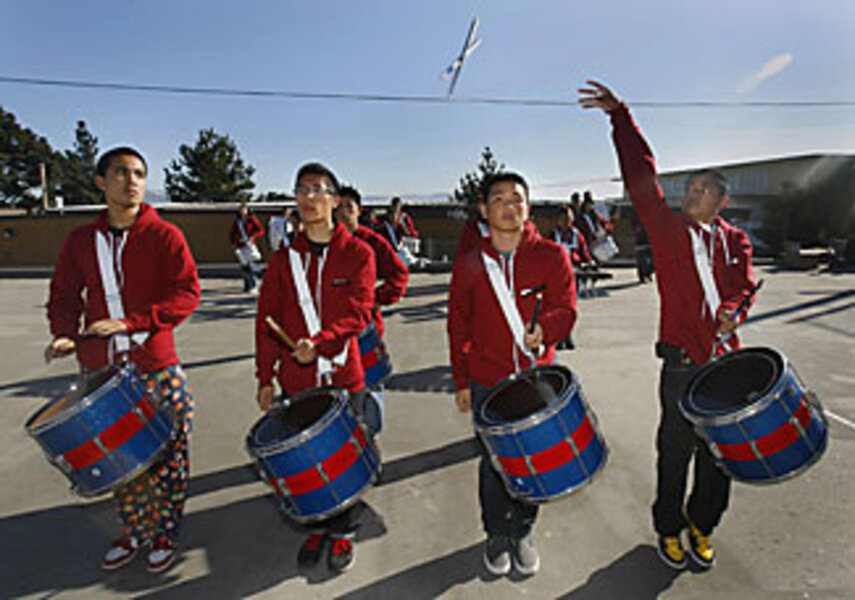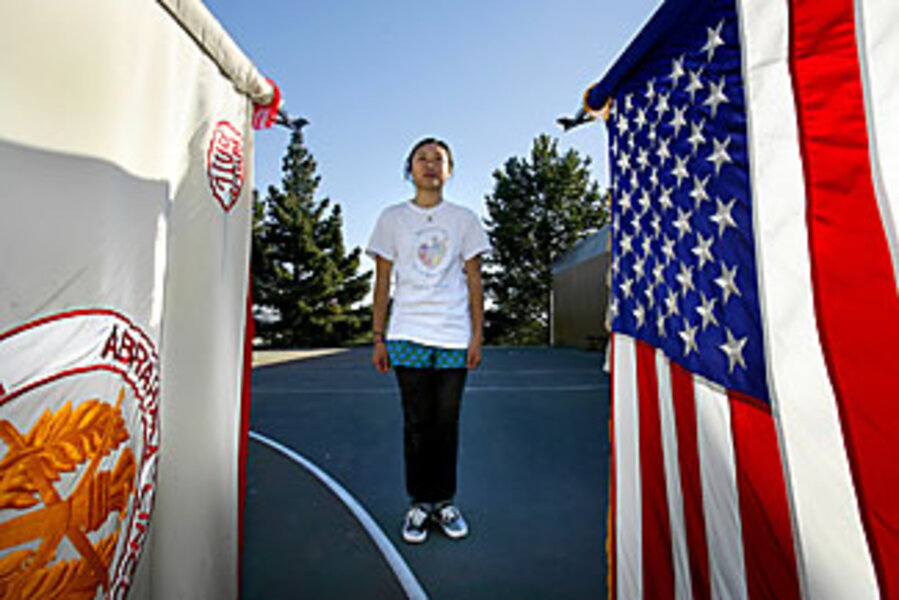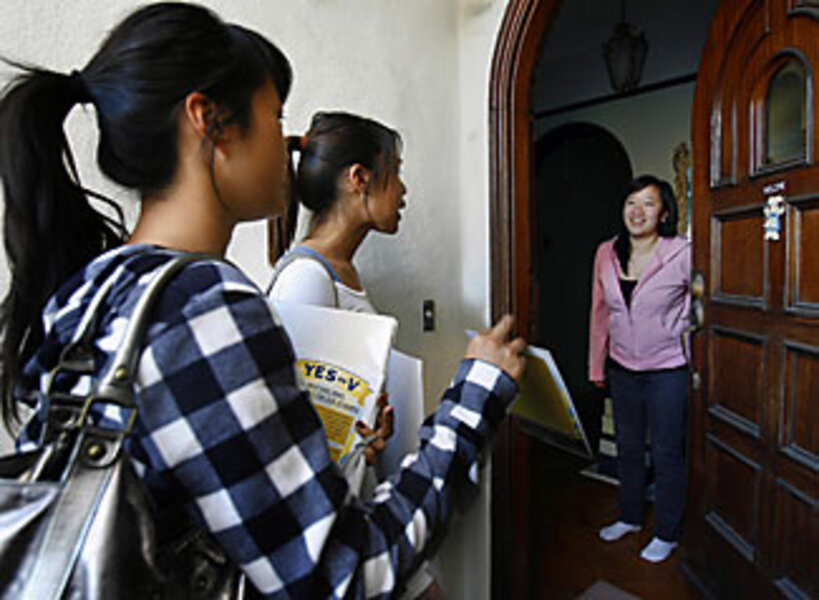JROTC: Leadership course or recruiting tool?
Loading...
| San Francisco and Washington
Some San Francisco students are taking to the streets over military involvement in schools – to support it.
On a recent afternoon, they are on 24th Avenue. Adeline Wong and Michelle Ha knock on every door down the block touting a ballot proposition that would save a military-tied program in their school. The city's board of education narrowly voted in 2006 to phase out military education courses, known as junior ROTC, arguing it was a form of recruitment.
Adeline, a senior at Lincoln High and the school's senior battalion commander, is trying to tell voters that her favorite extracurricular activity isn't grooming her to be GI Jane. "It's funny hearing other people's understanding of the program. It's so limited, so stereotypical – if you're in a uniform, you are going to go into the military," says Adeline, who is gunning for a master's degree in biotech.
Students in the program shake their heads over the adult battle that's erupted. The issue has sharpened skirmishes for local government seats, drawn verbal volleys from national pundits and activist groups, and grabbed the Pentagon's attention.
No other major urban school district has followed San Francisco's phaseout, but with emotions high over an unpopular war in Iraq, efforts to curb military engagement with students have gained traction across the country.
Antirecruitment efforts have taken place in schools in Seattle; Madison, Wisconsin; Vermont; and Chicago.
Supporters of junior ROTC like Adeline say the program pushes college, not the military, and fosters leadership skills and trusted friendships. Opponents, however, counter that the Pentagon would hardly spend money without it paying recruitment dividends.
"The reason it exists is to encourage people to be positively disposed to military careers. And because it is targeted to children who are 13, 14, 15, it's very inappropriate," says Dan Kelly, a retired school board member and leading junior ROTC opponent.
He and others point to statements by military leadership over the years that cast the program in terms of recruitment, including former Defense Secretary William Cohen who told Congress in 2000 that "it's one of our best recruiting tools."
By large majorities, San Franciscan voters have backed measures to insulate students from military recruiters.
Some 90 percent of students in the district opt to not allow their information to be passed on to recruiters, says Alan Lessik, regional director of the American Friends Service Committee. The issue isn't just about local opinion but about international law – ratified by the US Senate – that sets 15 as a minimum age for recruitment.
"The military knows the reality that if you wait until [age] 18 it's too late," says Mr. Lessik. "The Pentagon can get you if they start talking with you at 13."
Opponents in the city also oppose the military's "Don't ask, Don't tell" policy for gays and lesbians. The San Francisco junior ROTC program allows openly gay students to join and rise through the ranks, even if the military itself does not.
Effect on recruitment
There are about half a million students participating in more than 3,600 junior ROTC programs across the country, with budget authorizations to expand the program by another 100 units by 2010. Pentagon officials say that there's a "waiting list" of another 700 schools nationwide looking to get junior ROTC.
The Pentagon says the program is merely an opportunity to help foster discipline, citizenship, and a sense of national service. Yet the military is aware of its effects on recruitment.
Chiefs of the military branches told Congress in 2000 that between 30 to 50 percent of their junior ROTC participants ultimately join the military.
Advocates for the program in San Francisco suggest only a small percent of local participants go into the military, which couldn't be confirmed.
While the Pentagon announced last week it had met its active-duty recruiting goals, some top brass lament the negative perceptions held by some Americans about military service. They also argue the job of recruiting should be thought of as a national – not just a military – responsibility, one taken up by coaches, teachers, and others.
Today's youth do show an interest in national service, say military officials, but they also increasingly seek the approval of their parents or other "influencers" belonging to a generation shaped by the Vietnam War. The current conflict in Iraq doesn't help either.
Pentagon officials are reluctant to talk about the San Francisco case, though they are "concerned" about the seven junior ROTC units in area high schools. "If the local government feels it can no longer properly support the program, we view that with regret, but understand the constraints local schools are sometimes under," says Eileen Lainez, a Pentagon spokeswoman.
Enrollment in the city stands at about 1,200 students, down from 1,600 in 2006, Pentagon officials say.
However, the department is worried that the San Francisco school board's decision to prohibit cadets from receiving physical education (PE) credit for junior ROTC participation is negatively affecting participation levels, adds Ms. Lainez.
That decision came this summer and meant the district needed to hire 11 new PE teachers.
That's an expense that could be offset by ultimately laying off the junior ROTC staff, all of whom are retired military personnel. The district and the military divide the costs of the program, with the military chipping in $600,000 and the district paying $1 million. But it's hard to gauge the long-term financial impacts.
"This program has been in San Francisco for so long – 90 years – that we have literally built our schools with the presumption that we have junior ROTC in the schools, so we don't have enough facilities to provide PE for all the kids. We might have to build more gymnasia or fields," says Jill Wince, a school board member supportive of junior ROTC.
For some, a confidence boost
Students enrolled in the program take a daily course that covers everything from map reading to first aid skills to leadership training. The latter happens through a discussion of what traits a leader ought to have, followed by group role-play. Students put the training to use as they move up the ranks and take leadership positions in after-school activities including a drum corps and color guard, and drill teams.
"I'm a lot more able to speak up in front of everyone," says Dana Lui, leader of the color guard.
As for learning about the military, it rarely comes up. Junior Judy Yin can't remember a single discussion about military careers in the two years she has been involved.
"Colonel has specifically told me that if you can choose, don't go into the military," says Adeline. "He didn't say it's a horrible experience. But he said pursue other careers, go to college."
"Colonel" refers to retired Col. Robert Powell, head of the city's junior ROTC program. He says if students ask him about joining the military, he immediately tells them to talk with their parents first. Then he asks if they have considered all their options – college, trade school. And then, a stark question: "Do you know there's a war going on?"
He says he does not meet with or pass information to recruiters, nor is he allowed to do so. "Our mission is to encourage young people to be better citizens. It's hard to get people to believe that's the pure and sole objective."







